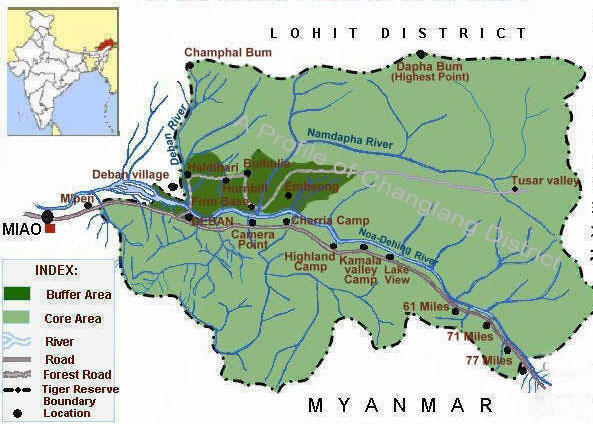Home ::Indian National Parks ::Namdapha National Park
Namdapha National Park
Arunachal's vast mountain forests, with gigantic trees and sunless forest floor, appear to be straight out of the pages of Tolkien. Among the most magical is the Namdapha National Park. replica japanese rolex watches The park, along with its surrounding forests is among the last large tracts of wilderness in south Asia. Flanked to the south and east by the Patkai hills and to the north by the high mountain passes and peaks of the Himalaya, it is a place deserving superlatives.

Two rivers, the Noa-dihing and the Namdapha, and numerous smaller streams divide its 1,985 km2 of rugged hills. Despite its remote location, the forests around Namdapha have always had people. The Lisu (Yobin), Singpho and Tangsa tribes have been practicing shifting cultivation here for generations, and the Chakma were settled in the area by the Indian government in the sixties. Namdapha was also on the famous 'hump' air-route from Assam to China during the Second World War, and local people still occasionally stumble upon old crashes of allied aircraft in the hills.

Spanning 200 metres to over 4,500 metres above sea level, Namdapha is exceptionally diverse in its variety of habitats. Tall and dark evergreen rainforests cover vast areas of the lowlands, with subtropical and temperate forest in the mid elevations. Further up are stunted rhododendron forests and subalpine meadows. Bamboo forests and canebrakes are common, often in impenetrable thickets in the valleys and along streambeds.
With such habitat diversity, an extraordinarily varied wildlife is no surprise. There are about a hundred mammal species, from the conspicuous and vocal hoolock gibbon to the elusive spotted linsang. Namdapha is the only park in India, and probably the world, with four large cat species – tiger, leopard, clouded leopard and snow leopard, although the presence of the last requires confirmation. At least 500 species of birds occur in Namdapha,shelby daytona coupe replica including global rarities like the Snowy-throated Babbler, White-bellied Heron, Rufous-necked Hornbill and Ward's Trogon. The reptilian and amphibian life still needs to be fully documented. Some of the better-known species are the king cobra, several pit vipers and the giant tree frog. The fish and invertebrate fauna remain largely unknown and it is likely that a multitude of species await discovery.
Despite Namdapha's famed diversity, most species remain elusive. Although birds abound, mammal sightings are few and far between, primarily because of hunting. Most often it is just a fleeting glimpse of an animal crashing through the dense forest. Tigers and elephants have been almost hunted out of the lowland forests. Sightings of even prey species are rare. Namdapha may not appear to hold much for the tourist who expects to see large creatures, but what one can see on foot with an experienced Lisu guide is more exciting and intimate than watching animals from a jeep with hundreds of other tourists.
This website showcases the biodiversity of the park, the area and its people, and also provides relevant information useful to any traveller to the area. Encouraging greater public interest, what is replica watches and limited community-based wildlife tourism to ensure economic benefits for local communities, is important for the future of Namdapha, one of the last great wild places.



